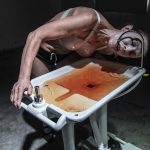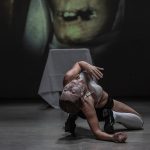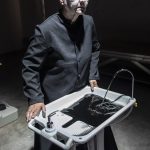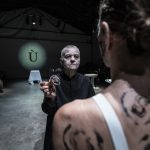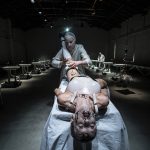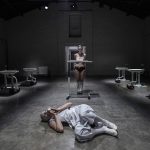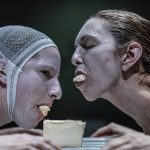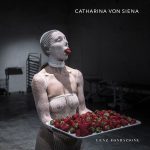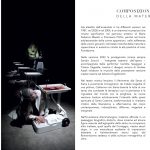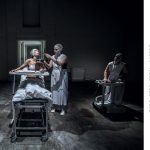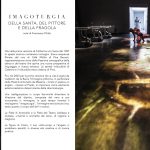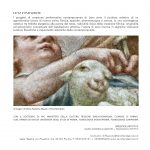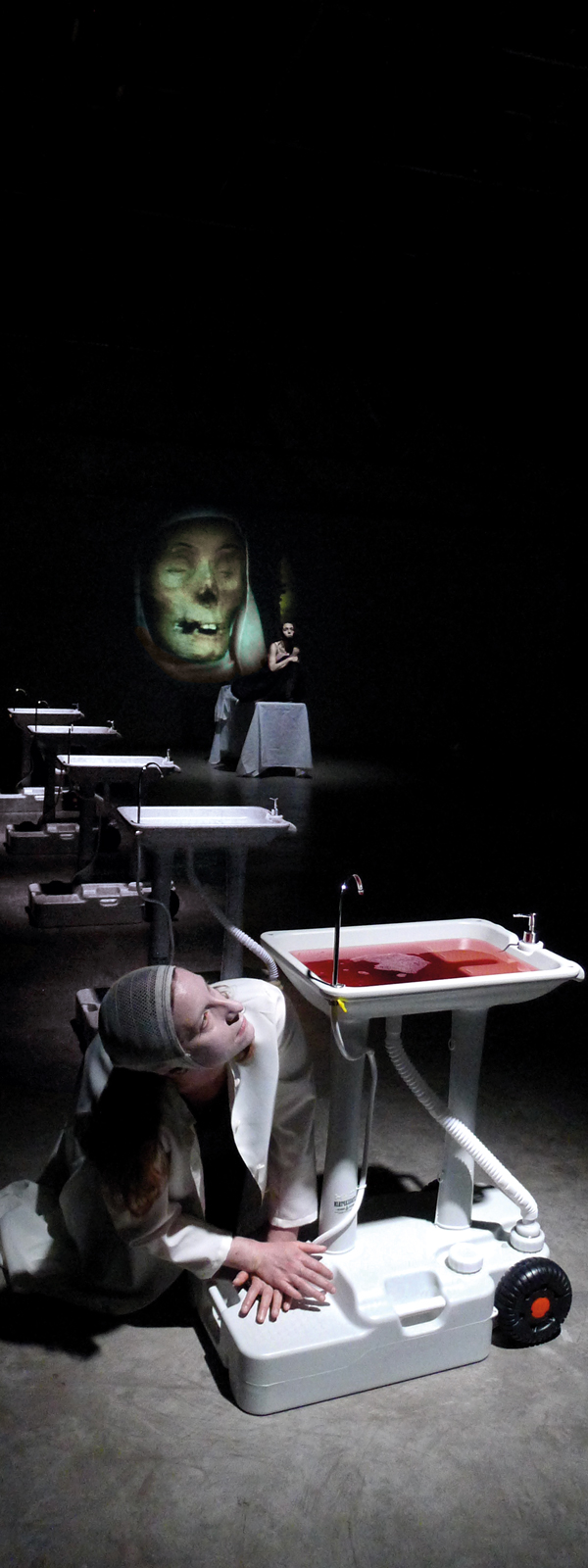
CATHARINA VON SIENA re-edition 2022
A succession of twelve sanctifying practices. A penitent lamb, she becomes the breath, the saliva, the ointment of Jesus in the fullness of the scourge. Nourished only by the host and the blood, she asks in a high-pitched voice to belong to the unclean of excess and to return to the extra-world of her childish nature.
LENZ’S LENZ
Staging project of the works of Jakob Michael Reinhold Lenz, through four re-edition creations: Catharina Von Siena, Lenz by Georg Büchner, Shakespears Geist, The Soldiers. Inspirational figure in 1985 of the birth of the artistic formation Lenz Rifrazioni (today Foundation) is a German playwright who lived at the end of the 18th century, a theologian and man of letters who died mad in Moscow at the age of only forty. Jakob Lenz expresses a strongly anti-rhetorical vision of the crisis of western man, anticipating with pre-Marxist sensitivity the great themes of the 20th century: anti-militarism, social injustice, violence against women, criticism of patriarchy and dominant male power.
Already staged by the ensemble in three different versions in 1987, 2000 and 2004, it is an unfinished drama that remains significant in the artistic journey of Maria Federica Maestri and Francesco Pititto, because in the adolescent fury of the first apparitions, in the suffering of youthful visions, and in the mystical ecstasy of maturity, the poetic ages of Lenz Fondazione are reflected in an authentic portrait.
In the 2022 version, the protagonist remains Sandra Soncini – ‘extreme interpreter’ of the work -, accompanied by performers Carlotta Spaggiari and Tiziana Cappella, while the sound design by Andrea Azzali reworks the music of the previous version created together with Adriano Engelbrecht. In Lenzi’s mystical theatre, the reference to the Saint of Siena is purely imaginary: from the initial tragedy of a painter, CATHARINA VON SIENA becomes the struggle of a saint who fights temptations with penitence and the injustices of the world with prayer. The new version artistically translates the intensity of Saint Catherine’s spiritual praxis, transforming it into a mystical reverberation of the liberation and affirmation of the contemporary, undisciplined, irregular and marginal body.
In the dramaturgical invention, Catherine sinks into a distorted biographical landscape, where together with some figures taken from the hagiography of the saint, other unexpected ones appear, such as that of Correggio, who lived centuries later, in an exhilarating mixture of literary inaccuracies and historical misunderstandings typical of German Romanticism and Lenz’s imaginative writing.
In the installation made up of ten stacked basins in which the chromatic verb of Jesus’ face flows, the time of mystical action is sculpted: Catherine is the phenomenon of God, the traces of his presence are engraved in her. Holy action and divine contemplation are accomplished in twelve trials, each revealing the matter and space of epiphany. The work is a succession of arduous sanctifying practices that lead Catherine to beatitude. The heavenly bride, a penitent lamb, becomes breath, saliva, the ointment of Jesus in the full fulfilment of the scourge.
Catherine’s body, nourished only by the host and blood, asks with a sharp voice to belong to the unclean of excess and to return to the extra-world of her infant nature. Blessed because without food, blessed because quenched by her own spit, blessed because dirty and without dignity. Catherine drowns in the realm of youths with livid and swollen veins, of queens with protruding bones, of schoolgirls of eternal regurgitation. Little Catherine wants to die. She wants to die in the theatre. And the theatre must die in Catherine, becoming itself cold, mute and rigid. Her resurrection is in the truth of the body, without identity, without will, without need, free to be God’s red strawberry.
IMAGOTURGY OF THE SAINT, THE PAINTER AND THE STRAWBERRY.
Introductory notes by Francesco Pititto. May 2022.
Already in our first version of Catharina von Siena in 1987, the stage space contained images. They were live filmed sequences of “Café Müller” by Pina Bausch, a visual representation of the choreographic Passion of dance and theatre that opened up a new perspective of language and artistic research. The irreducible sanctity of Catherine and the irreducible creative ethics of Pina.
Then, in 2003, for the first version of “Life is a dream” by Calderón de la Barca, the pictorial image, in particular Antonello da Messina’s “Pieta” – Christ in pity and an angel – taken from the Prado, imposed itself as a decisive aesthetic/esthetic element of the dramaturgy. A transfiguration in a female body became the refraction of the painting, composed from life and then reconverted into an image. At that time I invented the neologism ‘imagoturgy’, the image was living writing, as much as the actor’s body on stage.
Antonello’s Pietà and the Pietà of the Theatre, beauty and harshness, humanity and animality of the senses, of reason and unreason.
The figure of Christ, his face-body and the angel would assist us in different creative ages and poetic quests._ein Engel hinmuß, der die Bälge hochreißt. Engel und Puppe: dann ist endlich Schauspiel.
an angel comes to set the puppets in line. Angel and puppet: now it is theatre. Rainer Maria Rilke, from ‘Die vierte Elegie’.
In this remise en act of Catharina by J.M.R.Lenz, the face of Christ returns, like the young Christ in the Temple and the Face of Christ by Correggio, to interpenetrate into the face/head of the relic of Saint Catherine. What remains of its material and mortal shell.
A beyond death to be reunited with the Beloved, finally outside the physical body and the miserable human temptations. On the image lying on the ground is poured the liquid of suffering, the coloured fluids of illness and pain of the flesh, so similar to the chromatism of paintings. Almost as if to fill the veiled and fake colour of the silhouette with real matter, as if to summarise the electromagnetic waves that, having reached the brain’s sensors, determine its vision and end.
Finally, the strawberry, the fake fruit that contains the real fruit, which are then the small yellow seeds that are the achenes, the strawberry, the only one to penetrate the seed and show it to the outside, to expose it without shame, all immersed in the blood-red of its colour. All immersed in the fleshy, voluptuous, protective body of a strawberry as big as the Universe.
Catharina von Siena From Jakob Michael Reinhold Lenz
Rewriting, imagoturgy Francesco Pititto
Composition, installation, enclosures Maria Federica Maestri
Music Andrea Azzali, Adriano Engelbrecht
Actress Sandra Soncini
Perfomers Carlotta Spaggiari, Tiziana Cappella
Technical care Alice Scartapacchio, Giulia Mangini
Project care Elena Sorbi
Organisation Ilaria Stocchi
Press office, communication Elisa Barbieri
Diffusion, promotion Alessandro Conti
Production Lenz Fondazione








